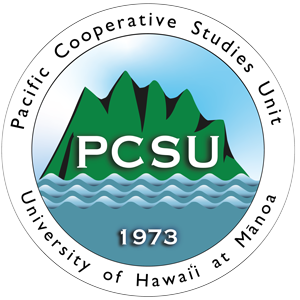
Rubbervine (aka Rubber Vine)
Cryptostegia grandiflora and C. madagascariensis
Species Info General
Family: Asclepidaceae
Rubbervine is a fast-growing climbing plant from Madagascar that is invading Hawaii. It smothers and restricts otherplants from growing by winding around trunks, stems and branches.
The Division of Forestry and Wildlife of the Hawaii Department of Land and Natural Resources has designated this species as one of Hawaii’s Most Invasive Horticultural Plants.



Identification/Description
- Fast growing, climbing plant usually with pinkish-purple flowers (sometimes white to pink or light purple). Can also grow as a bush.
- Shiny, dark green leaves that are about 7 cm (3 in) long, with triangular, 10 cm long (4 in) seedpods that grow in wing-like pairs.
- Native to Madagascar, introduced to Hawaii as drought-resistant ornamentals.
Impacts
- Grows over other plants and trees to 13 m (45 ft) high, smothering and killing other vegetation.
- Twines tightly around other plants and restricts their growth.
- Extremely poisonous: it contains cardiac glycosides, which interfere with heart operation in humans and animals when the plant is eaten.
- When the vine is dry, a powdery dust emerges and can cause violent coughing, swelling of the nose, and blistering of the eyelids.
- Contact with the plant’s milky sap can cause burning rashes and blisters.
- Each seedpod contains 340-840 seeds, silky hairs on seeds allow them to spread by wind and water, seeds are also known to float and survive for a month in salt water before being washed ashore to sprout.
- Introduced to Western Australia, now considered one of the 10 worst invasive plants.
In Hawaii
- Kauai – Present in limited numbers in ornamental settings, but not a KISC target at this time. Property owners are encouraged to remove this plant from their land (carefully).
- Oahu – Present in landscaped areas including Diamond Head, Hawaii Kai and Bishop Museum; infestations also occur. OISC is currently determining the feasibility of controlling rubbervine. All population sightings should be reported to OISC for mapping and assessment.
- Maui – There are a few sites on Maui that are being controlled by MISC. Unfortunately, rubbervine is widely available to the public through internet seed companies, few of which describe the plant’s invasive qualities.
- Molokai – One large infestation is known, from a couple of original plants distributed by a home gardener in East Molokai. MoMISC is unable to control this infestation with current resources. Landowners are encouraged to control this plant and to call MoMISC for control advice.
- Lanai – Presence/absence unknown
- Kahoolawe – None known
